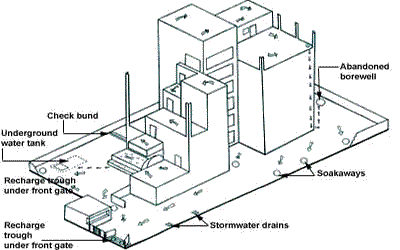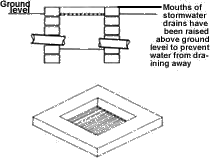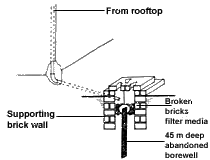In 1999, CSE installed a water harvesting system in its office premises at Tughlakabad
Institutional Area, New Delhi. The system was designed in a way to ensure that drainage of
rainwater from the premises is practically prevented, and maximum amount of rainwater is
effectively harvested. For recharging the water, 13 soakaways have been constructed around
the building. Each soakaway is 9 m deep and is filled with brickbats to act as a filter
media. The mouth of each borewell is covered with an inverted earthen pot with a small
hole to prevent the entry of debris which could clog the borewell. Further, the pot is
surrounded by brickbats (broken brick pieces) to filter the runoff entering the well, and
the entire assembly is covered with a jali – a perforated cover. Water that
falls on the unpaved areas surrounding the building enters these soakaways and percolates
into the ground.
An 45 m deep abandoned borewell in the premises has been converted into a recharge
borewell by connecting the rooftop drains to it. Runoff from the terrace is passed through
a grating to filter it before passing into the borewell. Water from the some portion of
the terrace falls into an open pond in the front of the building, from where it overflows
to an underground water tank of 8500 litres capacity.
 |
FIGURE 1: A view of the entire system |
Openings of the municipal
stormwater drains within the area have been raised slightly above the ground level, so
that rainwater does not drain away, except in case of a heavy downpour (see figure 3 ). To
prevent water from flowing out of the campus through the gate, three soakaways have been
constructed in a trough under the front gate.
 |
 |
FIGURE
2: Detail of recharge borewell |
FIGURE 3: Storm drains raised to prevent water from draining |
Because of the water harvesting system, only in case of an extraordinary downpour would
water flow out of the CSE campus and it is ensured that all the rainwater falling over the
building area is recharged or stored.
A rain gauge and water meters have been installed to monitor the rainfall and water-use
in the building. On 13 March 2000, a short rainstorm of 7.5 mm occuring over 32 minutes
was recorded, which effectively recharged about 4500 litres of water over the CSE area of
1000 sq m Although this quantity is not very large, it is interesting to note that this
small shower contributed an amount of water equal to about 6 days of drinking water
requirement of the entire 110-strong CSE staff at 10 litres per person per day.